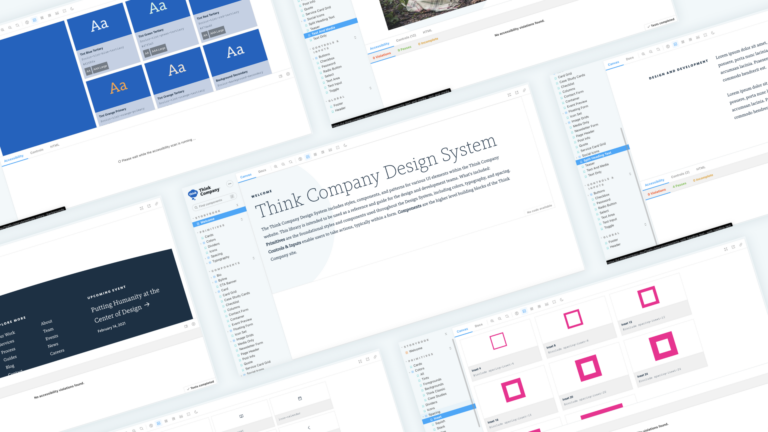
It’s common for financial services businesses to have multiple products and brands underneath the umbrella of their larger organization. Managing these numerous sites can be unruly and create usability, accessibility, and technology issues for users and those managing these digital assets.
We’ve helped many midmarket and enterprise teams attract and retain customers with modern digital experiences that meet and exceed customer expectations. Even though every company is different, there are some commonalities in this process that can benefit anyone. Learn how financial services organizations can successfully oversee various related brands.
7 best practices for improving your customer’s experience
1. Reimagine your login experience
Many companies have different platforms for each financial product, and each of those platforms has its own login experience and credentials. People often don’t know what product they have; they just know they’re with your company. You can have one set of credentials for the person to use that is tied to all products within your company.
So instead of a customer having to locate the correct product before logging in, they just log in, and the business knows what products they have and can manage. The alternative is like going to a bank and the teller asking what types of accounts they have before asking for an account number.
Offer a no-login-required experience
There is valuable information you can provide customers that doesn’t need to live behind a login screen. Offering a few CTAs that don’t require a login can improve your current customer (and potential customer) experience.
If a user is trying to find a new provider they may be in the awareness or conversion phase of your marketing funnel, forcing them to provide personal information could deter them from converting. Creating a path and CTA—”Find a Financial Professional”—that allows them to find valuable information (agents, reviews, etc.) without being forced to hand over personal information could lead to increased confidence in their decision-making process and an overall better experience.
2. Clarify site navigation
Don’t make users work harder than they need to when moving through your site(s). Clearly indicate when a link will open another tab, prompt a download, or open a PDF. And make sure to use specific CTA text. “Learn more” is familiar but vague. Help your audience understand more clearly what they’ll find when they click.
Looking to improve your customer experience?
We can help your team attract and retain customers with modern digital experiences.
For example, maybe your company offers educational resources for retirement and investing; a CTA linking to a blog post could read “Get ready for retirement.” Perhaps you offer information on tools customers can use to manage their financial health; the CTA could read “Access the toolkit.” In both these instances, your CTAs give users a clear idea of what is on the other side of the link and the potential value it provides.
3. Examine your sites’ information architecture
Is the information on your site(s) placed when and where users need it? Timely, actionable information that is easily accessible is hugely successful. Resources related to timely issues like layoffs or COVID-19 placed front and center help customers understand how their products or services are affected or how your business is addressing a current issue. The more specific you can be, the better. Think about your offering and how it interacts with the situation at hand.
4. Design with mobile at the forefront
We’re always on the go, and customers are used to having access to their finances anytime, anywhere. That means your customers spend a lot of time on their mobile devices and value the freedom to access funds, make investments, etc., on your mobile application. Spend the time and resources to ensure your products are designed for a modern mobile experience—gain the trust of your customers.
5. Create clear pathways to customer support
Sometimes, talking with a human when processing a financial transaction is easier and necessary. Be sure that your digital financial services product creates clear pathways for customers to connect with your customer service team. In moments of financial urgency a seamless customer support experience can build or break trust.
For example, a chatbot that quickly gathers information from the customer and gets them set up with the right service representative in the correct department. Don’t send your customer to a mountain of help pages right off the bat—offering multiple ways to contact your customer service. Whether by chatbot, email, or phone, your application should be designed to effectively guide the customer where they need to go to get their answers.
6. Include easy-to-understand data visualization
We all do it; when presented with a slew of numbers, we quickly try to do the math in our heads—the pressure is on. Working with numbers and finances can be high-stress, so help ensure your customers can easily translate the information with digestible data visualizations. A bar chart or line graph can go a long way when someone wants to understand the progress or breakdown of their financial investments. This visual depiction can take the complexity away and provide the details they need, quickly.
7. Utilize personalization and tailored content
Every customer is different, and in financial services, you likely won’t see two alike. What may be important to one person might not be to the next. So, your digital applications must be flexible enough to provide your customers with the personalization they want and need. Remember, there is a fine line between helpful, relevant content and highlighting too much personal information.
An example of helpful personalization might be providing customers with investment trends based on their interests to help inform their investment decisions. Allowing customers to view quick charts and short summaries that relate to their funds without having to dig through a load of information can go a long way and build confidence. These quick hitters can serve as an entry point into further resources that customers might be interested in learning about. Building trust by offering personalized info based on their needs and thought leadership opportunities will keep you ahead.
Better UX for multiple financial services brands
Managing these various brands under one umbrella is complicated and can trip up even the most experienced teams. Customers feel the hit when they try to navigate between sub-brands and sites and encounter usability, accessibility, and tech issues.
If your company is trying to build and maintain modern digital experiences that attract and retain customers, these best practices can help you get there.
Want to learn more about how to manage multiple financial services brands better? Schedule a call with us.



